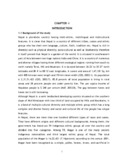Please use this identifier to cite or link to this item:
https://elibrary.tucl.edu.np/handle/123456789/2241| Title: | Socio-Economic Status of Magar Community A Case Study of Devisthan VDC, Baglung District |
| Authors: | Sinjali, Tejindra |
| Keywords: | Socio economic status;Study;Community |
| Issue Date: | 2019 |
| Publisher: | Central Department of Rural Development |
| Abstract: | The study highlights the socio-economic status of Magar community of Devisthan VDC of Baglung district. Primary data was collected from the field using sample survey, covering total 45 respondents and 6 key informants. Stratified random sampling technique was applied to select the sample and interview schedule was made to collect the information and data. The main objectives of the study are as follows: • To examine socio-economic condition of the study area. • To analyze socio and cultural changes in the Magar community. • To explore the problems of Magar community. However, study area is a rural area. Most of the families are involved in agriculture. Study finds above 50 percent of the sampled families have food insecurity situation. In the study area, most of the families have domestic animals for the purpose of manure, milk, meat, and eggs only. It could not develop as professional occupation. So, their economic condition is miserable. The average family size is 5.52. Educational Status of the study area is not bad on the whole. The literacy rate in study is 40 percent than national average (54.1%) similarly female literacy rate is also very low. The Magar of the study area had their own way of influenced by Hinduism. But the social status of Magar in the study area is not well established. The study highlights the socio-economic status of Magar community of Devisthan VDC of Baglung district. Primary data was collected from the field using sample survey, covering total 45 respondents and 6 key informants. Stratified random sampling technique was applied to select the sample and interview schedule was made to collect the information and data. The main objectives of the study are as follows: • To examine socio-economic condition of the study area. • To analyze socio and cultural changes in the Magar community. • To explore the problems of Magar community. However, study area is a rural area. Most of the families are involved in agriculture. Study finds above 50 percent of the sampled families have food insecurity situation. In the study area, most of the families have domestic animals for the purpose of manure, milk, meat, and eggs only. It could not develop as professional occupation. So, their economic condition is miserable. The average family size is 5.52. Educational Status of the study area is not bad on the whole. The literacy rate in study is 40 percent than national average (54.1%) similarly female literacy rate is also very low. The Magar of the study area had their own way of influenced by Hinduism. But the social status of Magar in the study area is not well established. |
| URI: | http://elibrary.tucl.edu.np/handle/123456789/2241 |
| Appears in Collections: | Rural Development |
Files in This Item:
| File | Description | Size | Format | |
|---|---|---|---|---|
| Cover Page(5).pdf | 58.65 kB | Adobe PDF |  View/Open | |
| CHAPTER(1).pdf | 313.93 kB | Adobe PDF |  View/Open |
Items in DSpace are protected by copyright, with all rights reserved, unless otherwise indicated.
